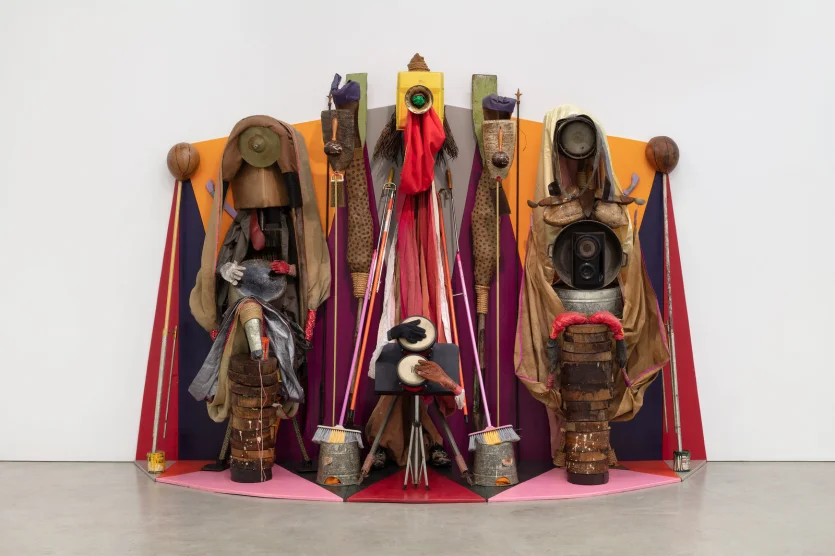PROTODISPATCH
A monthly digital publication of artists’ dispatches on the life conditions that necessitate their work.
23 OCAK, 2024
23 OCAK, 2024
INTEGRATIONIST RACISM AND CONTEMPORARY ART IN PUERTO RICO IN THE WAKE OF BLACK LIVES MATTER
Poet and writer Mayra Santos-Febres contextualizes the survival of Afro-Borinquen artmaking within legacies of colonialism in Puerto Rico and the Caribbean, highlighting liberatory methodologies and refusals to be unseen. In 2022 Protodispatch published another exploration of cultural survivance in Puerto Rico titled Relearning the Ancient: Paths to the Indigenous land rights in Boriquén by Jorge González and Angela Brown.
Mayra Santos-Febres
ในรูปแบบภาษาไทยโดย GroundControl
En español en 80grados
Türkçesi Argonotlar'da
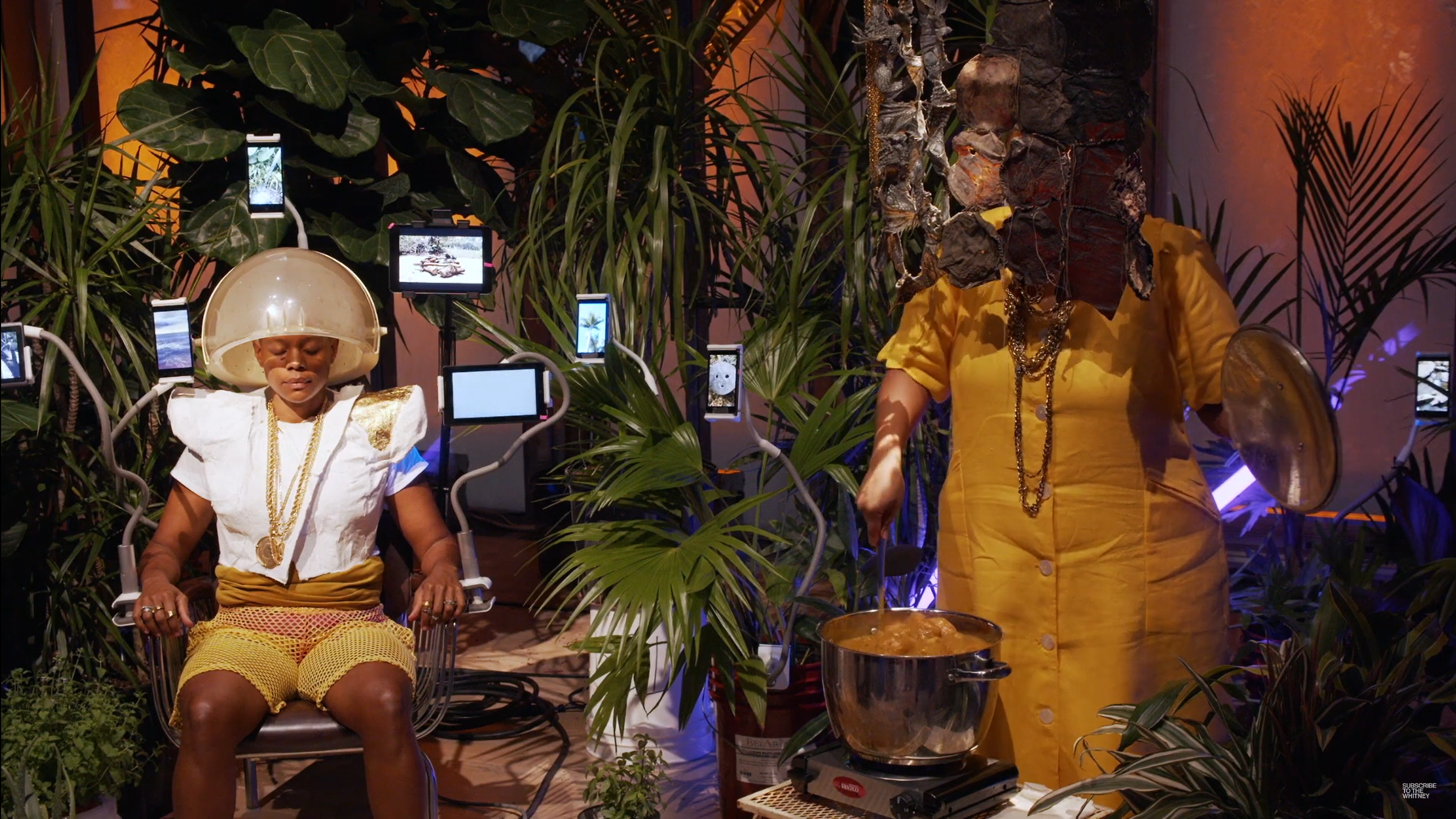
Twenty-six years ago, visual artist and curator Edwin Velázquez initiated a movement that transformed the landscape of visual arts in Puerto Rico, paving the way for decolonial artistic practices that reflect and affirm Afro-descent within the Caribbean and its diasporas. In a now-distant 1996, Velázquez inaugurated Paréntesis: Ocho Artistas negros (Parentheses: Eight Black Artists), an exhibition that showcased the works of Arleen Casanova, Daniel Lind-Ramos, Gadiel Rivera, Jesús Cardona, Luz D. Amable, Awilda Sterling-Duprey, and Ramón Bulerín. All of these artists had been working for decades on visual art from Afro-Diasporic Caribbean traditions. However, traditional art circuits—galleries, museums, artist grants, and critical appraisal—insisted on ignoring their presence and work on the island and in the United States. Racism against Afro-Puerto Ricans and the deep Eurocentrism that has long shaped the established international art world were as embedded as ever, despite decades of decolonial protest. By racializing the descendants of Latin American immigrants born or residing in the United States as “Latinx,” a stubborn and incorrect view of such identity has evolved. This construction creates a "double invisibility" similar to the “double consciousness” described by W.E.B. Du Bois for "Afro-Latinx” artists as they face a “double invisibility" that sharply separates "Latinx" identities from "Afro" identities and insists on an erasure of Blackness in Latin America. In this scenario, the "Afro-Latinx" is neither understood nor recognized in any profound way, an especially egregious circumstance given that this confluence of identities has existed for more than 400 years, is intrinsic to Latin America and its diasporas, and shapes its cultural expressions.
Racism against Afro-Puerto Ricans and the deep Eurocentrism that has long shaped the established international art world were as embedded as ever, despite decades of decolonial protest.
The reception of Paréntesis: Eight Black Artists sparked a compelling controversy, shedding light on the mechanisms of racism prevalent not only in Puerto Rico but also in numerous other Caribbean and Latin American nations. Shortly after the exhibition's inauguration, droves of letters to the editor and newspaper articles questioning the necessity of grouping artists based on their racial identity surfaced. Among the criticisms directed at Paréntesis was the argument that “art is universal.” Categorizing art based on criteria other than its artistic merit was considered a “divisive” act and labeled as “reverse exclusion.”
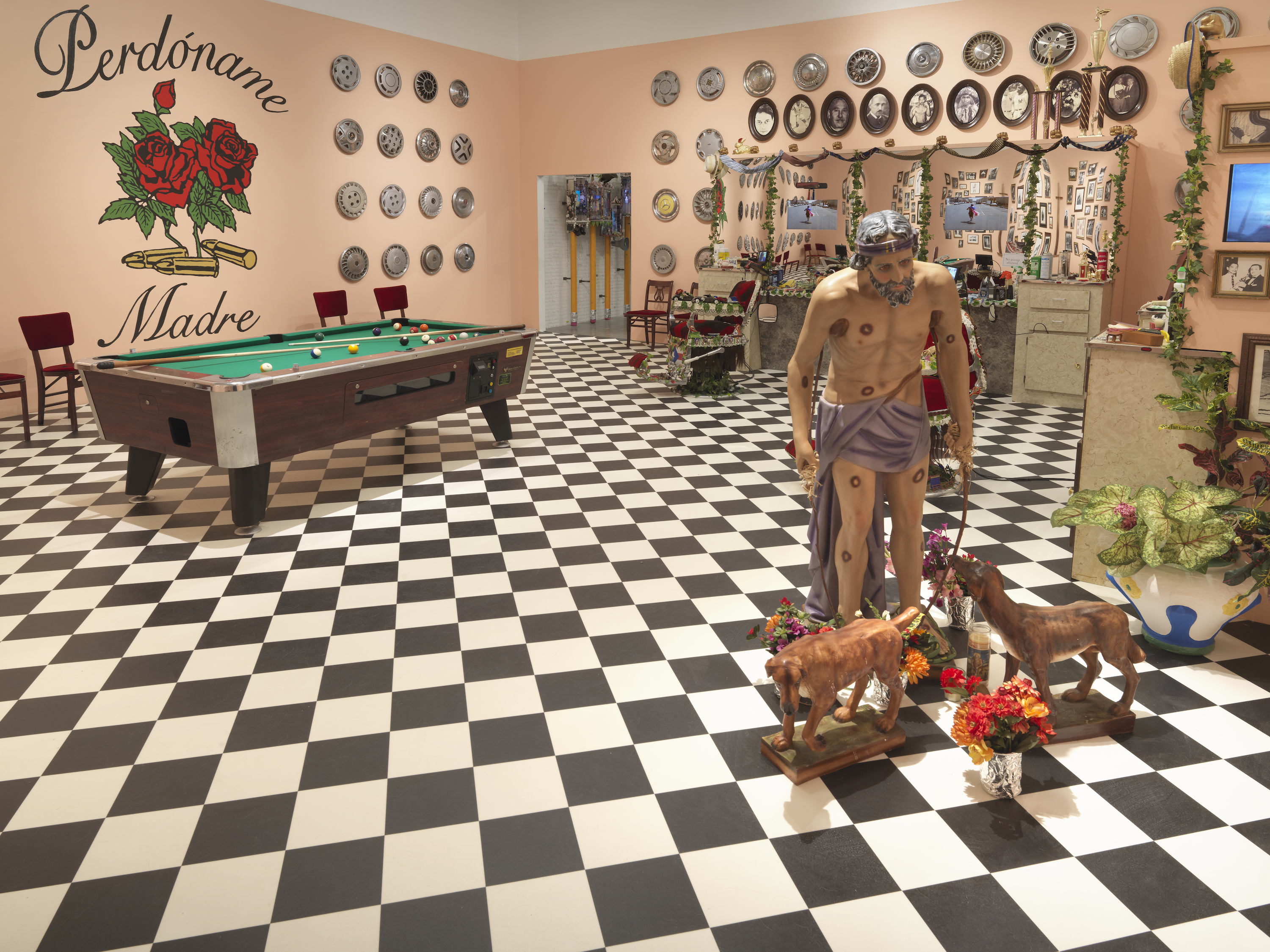
We must understand that racism within our Caribbean and Latin American territories functions predominantly through denial. Refusing to acknowledge its existence sustains racism in Latin America and the Caribbean. Consequently, this denial stifles any discourse regarding racial issues, perpetuating what I describe as “enforced integrationist racism.” This form of racism is upheld by official narratives that promote a racial democracy and claim the resolution of all ethnic tensions within the diverse spectrum that constitutes the Latin American identity. It is important to emphasize that this “forced integrationist racism,” is very different in nature to the “forced segregationist racism” that operates in the United States.
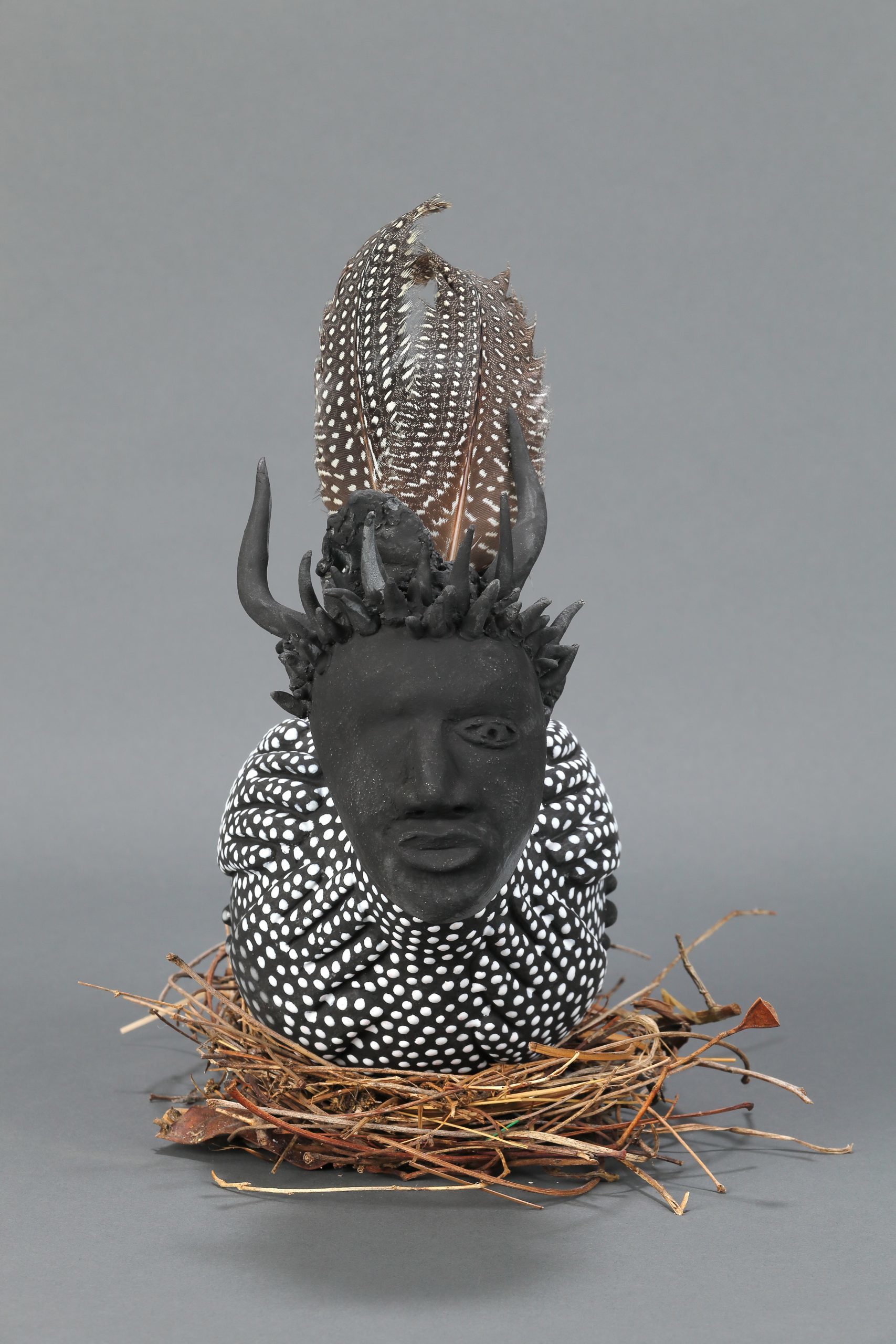
Following the murder of George Floyd and the rise of the global Black Lives Matter movement, however, conversations surrounding race and anti-Black discrimination have gained significant traction in Latin America and the Caribbean. Exhibitions of Black-identifying Puerto Rican artists on the island have experienced exponential growth since 2020. It took 26 years for this movement to finally unfold, tentatively paving the way for including Afro-descendant Latinx artists in museum and gallery spaces, and their gaining recognition and access to scholarships and critical responses, not to mention financial support, to enable them to continue their work. Artists who received international awards but remained invisible in the art circuit of Puerto Rico or the United States have begun to be recognized and supported for their work. Pepón Osorio, Daniel Lind-Ramos, Awilda Sterling-Duprey, Gadiel Rivera, and Edwin Velázquez were recognized with both exhibitions and awards from august institutions such as the Whitney Museum of American Art, New York’s Museum of Modern Art, the Mellon Foundation, the MacArthur Prize, and other entities mainly from the U.S. Because of such recognition, island-based museums and institutions have had no other choice but to recognize Afro-Boricua artists. The colony had to be good for something! Black Lives Matter has shaken the foundations of art institutions, on both the island and the mainland, and forced them to open their doors to those who had long remained on the art world's periphery.
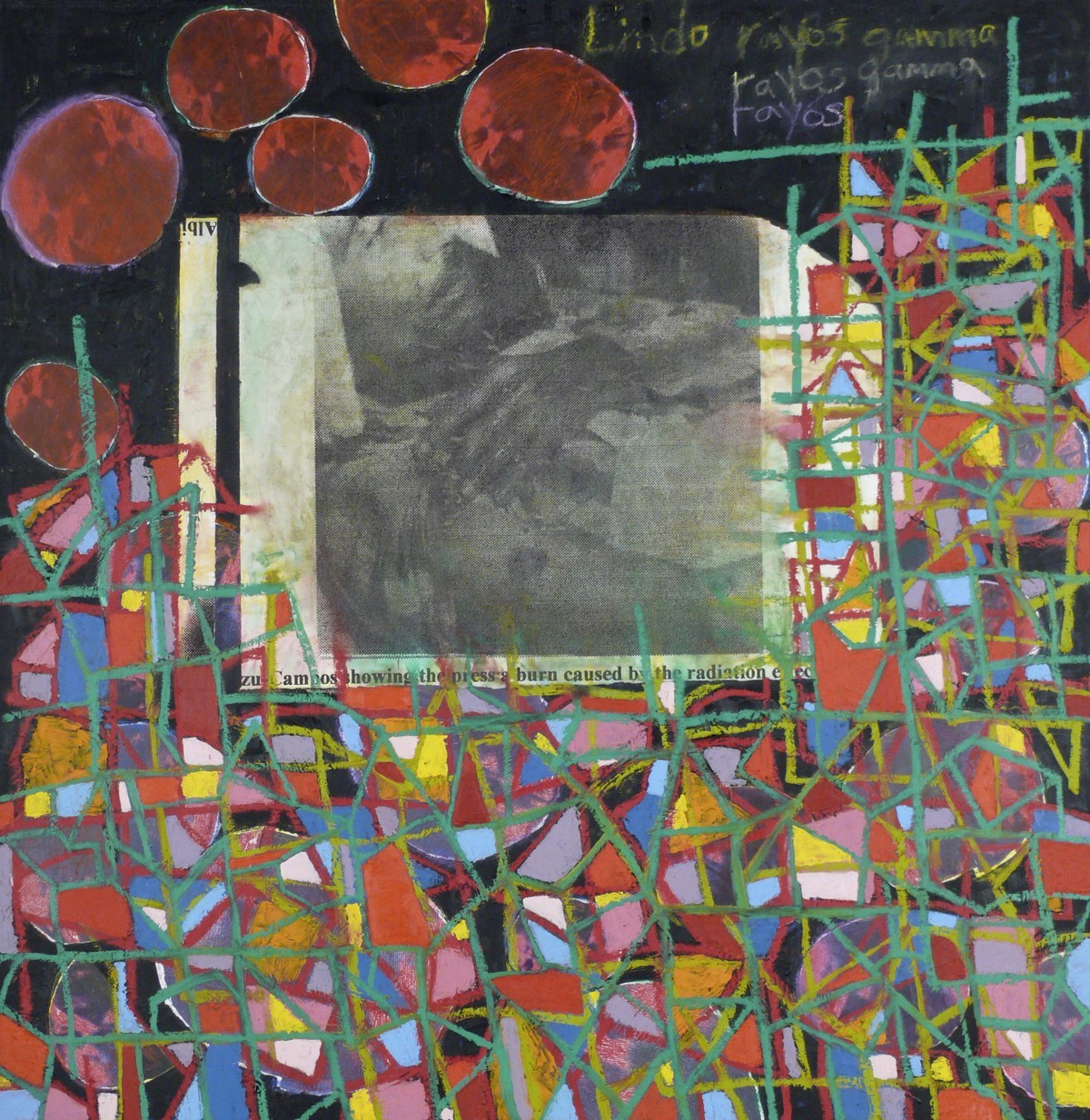
Producers of Afro-visual art distinctly counter many classical tendencies that typically appear in museums and galleries, confronting the patriarchal and exclusive Eurocentric model along with its established circulation networks. In many of these works, the protagonism of the Black body imposes itself as the living memory and presence of the horrors of slavery and racism. Afro-Boricua art re-positions these bodies and recontextualizes them in their own systems of references. They are bodies inserted into and interacting with their territorialities, communities, and ancestralities that re-read history, ethics, and aesthetics in Puerto Rico from the perspective of the experience and memory of racism and racialization within the context of Puerto Rican culture.
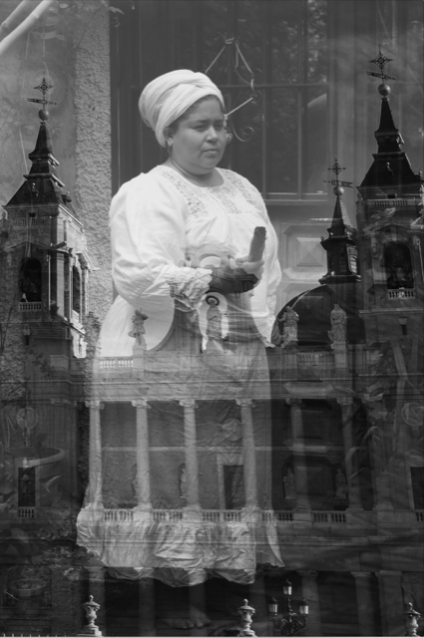
In Awilda Sterling-Duprey's performance I am the reincarnation of an enslaved soul (2021-22), Maestra Sterling re-envisions Goyita (1953), a portrait by the great painter Rafael Tufiño of his mother, Gregoria Figueroa. Sterling-Duprey inserts the portrait into the contemporary conditions of Puerto Rico, where the model of progress imposed by U.S. colonization has failed. In this performance, the narrative that contextualizes contemporary Afro-Boricua art takes shape. The racism of forced Afro-Latinx/Boricua integration and the logic of colonization of the people of Puerto Rico and their diaspora frames the thesis: that slavery never ended. These thematics are similarly taken up in the performances of Brenda Torres-Figueroa, Brenda Cruz, Deyaneira Lucero Maldondo, and Las Nietas de Nonó (Mulowayi and Mapenzi). The inscription of the ancestral/community vision is foregrounded, proposing the figure of the Mayores and Mayoras—grandmothers, aunts, comadres, godmothers, parents, and godfathers—in a re-corporealized form, re/embodied in the personal/familial history and/or in the very body of the artists. In this way, they propose a familial/communal interweaving as the origin of the definition of the subject that rescues the Afro-Caribbean identity erased by official history and Eurocentric discourses. The proposals of self embedded in the storytelling of Sterling-Duprey, Cruz, Torres-Figueroa, Mulowayi, and Mapenzi is re-embedded in the body, the experience, and the historical, political, and racial memory, an identity that has not been "transcended," according to modern definitions of time and history, but that is still alive in and from the body. It is a relationship to the individual that is interconnected, fractal, multiple, and creative, and it proposes the existence of an embodied memory that is activated by voice, movement, and the very act of visualizing, creating, and enacting a work of art. The works, then, operate as portals to experience. The poetics of these activations of the living self invites a deep connection to history and the self as multiple—ephemeral and yet profoundly meaningful. This construction shatters traditional conceptions of art as an object of the market and of validation by museums and galleries and redefines Afro-visual art as a process both communal and ancestral, in connection with the experiences of others, as well as with land as a zone of redefinition of existence and identity.
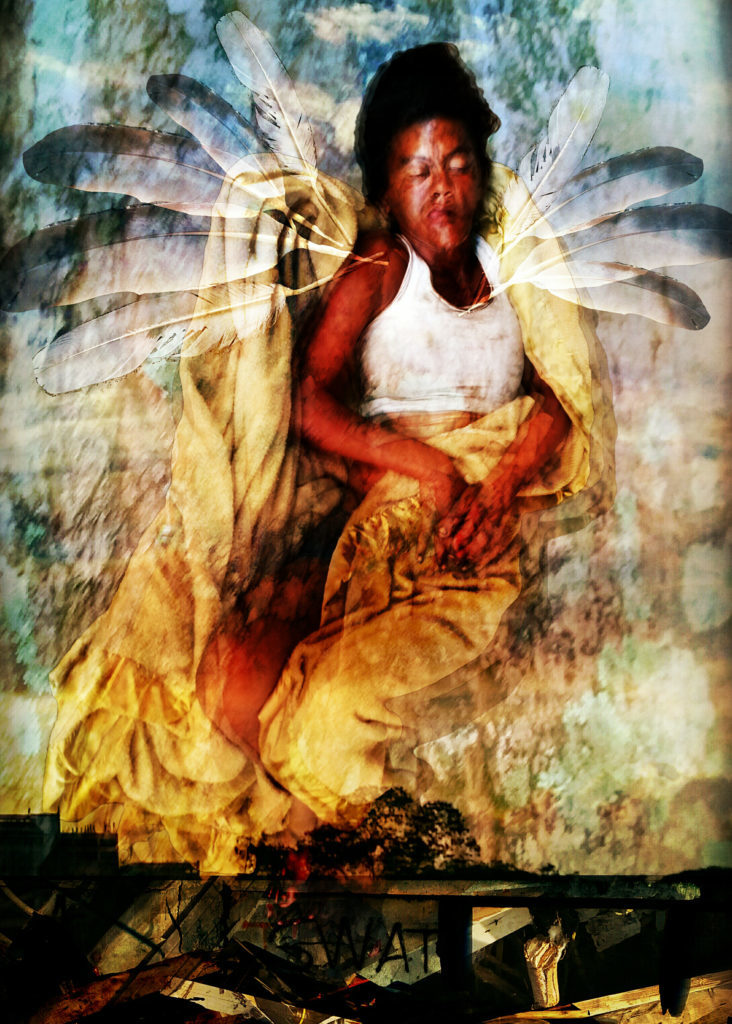
This set of concerns is central to diverse artworks and installations by Pepón Osorio, Diógenes Ballester, Imna Arroyo, Celso González, José Arturo Ballester Panelli, as well as to paintings and murals by Nuyorican graffiti artist Juan Sánchez, the masks of Juan Pablo Vizcaíno, and the assemblages of Daniel Lind-Ramos. Their common thread is occupying space (whether public, alternative, or in museums) with their artistic proposals. They present visual art in Puerto Rico as an avenue for reconnecting with the environment, nature, and memory, all elements that have undergone racialization. These practices resist the two-dimensionalities of the picture, or the photographed or painted artwork. In their use of found, ephemeral, or natural materials, they insist on an interaction of art with life and community. Their use of these materials allows these artists to see the island-archipelago, its neighborhoods and barrios, and, from there, recompose an Afro-Boricua aesthetic that focuses on creating new ancestral objects. These works build alternate meanings in their storytelling, redefining what is beautiful through the very materials employed. The materials speak: the barber's chair, leaves, pigments, natural fibers employed not only as medicinal aids but also to nurture/heal racialization and social marginalization. Further use of family photographs, letters, videos, and items symbolizing “my people from the neighborhood” and the artists’ origins and belongings ground the work in this alternate space. Rather than adopting an anthropological or sociological perspective, the viewpoint emerges from within, disrupting the paradigm of spectacles that depict the primitive. This perspective eschews the romanticized notion of nature as a mere landscape and aligns with a sacred perception of the intertwining of all living entities. It seeks to redefine humanity not solely as a producer of progress but also as a natural force in harmony with all existence.
It is worth highlighting that current Afro-Boricua aesthetics weave together three key elements: the body and its re-existence, the languages of Afro spirituality and nature, and the spaces and languages created by the migration of Afro-Boricuas to the northern U.S. These elements, alongside their clashes with contemporary society, produce meanings of potential healing. It is an unstoppable movement, an alternative register of artistic production that, in spite of the racialized constraints of the traditional art circuit on the island and abroad, enables ways to see our world anew. The colonizers can no longer cover the sky with their hands. Another reality is imposing itself and will impose itself, expanding the visual world of the world to include yet other worlds.
Read Past Protodispatches here
* * *
ภาษาไทย
การเหยียดเชื้อชาติแบบบูรณาการ และศิลปะร่วมสมัยเปอร์โตริโกในรุ่งอรุณแห่ง ‘Black Live Matters’
(บทความนี้เป็นส่วนหนึ่งของการร่วมมือระหว่าง GroundControl และพันธมิตรสื่อทางศิลปะ Protocinema
ผู้เผยแพร่สื่อดิจิทัลด้านศิลปะรายเดือน
เพื่อนำเสนอมุมมองของศิลปินที่มีต่อสังคมร่วมสมัย การเมือง วัฒนธรรม
สิ่งแวดล้อม และเศรษฐกิจ โดยดำเนินการผ่าน Protodispatch
ผู้เป็นตัวกลางเผยแพร่ข่าวสารประจำเดือนให้แก่พันธมิตรในเครือ โดย
GroundControl
ได้รับเกียรติให้เป็นพันธมิตรสื่อเพื่อเผยแพร่บทความในภาษาไทย ร่วมกับ Artnet.com จากนิวยอร์ก และ Argonotlar.com
จากอิสตันบูล เพื่อร่วมกันสร้างโครงข่ายของระบบนิเวศน์ทางศิลปะที่เข้มแข็ง
และเพื่อให้ผู้สนใจศิลปะชาวไทยสามารถเข้าถึงได้โดยปราศจากกำแพงด้านภาษา)
กวีและนักเขียน เมย์รา ซานโตส เฟเบรส (Mayra Santos Febres) นำเสนอกลวิธีการเอาตัวรอดของศิลปะแอฟโฟร-โปรินเกน (Afro-Borinquen — ชาวเปอร์โตริกันเชื้อสายแอฟริกัน) ภายใต้โครงสร้างมรดกตกทอดทางความคิดของลัทธิอาณานิคมในเปอร์โตริโกและแคริบเบียน ด้วยการนำเสนอกระบวนการปลดแอกและการปฏิเสธที่จะถูก ‘ทำให้มองไม่เห็น’ โดยย้อนกลับไปเมื่อปี 2022 Protodispatch เคยเผยแพร่บทความที่สำรวจของการเอาตัวรอดทางวัฒนธรรมในเปอร์โตริโกภายใต้หัวข้อ เรียนรู้ใหม่กับสิ่งโบราณ: หนทางสู่สิทธิในที่ดินของชนพื้นเมืองในโปริเกน โดยฆอร์เก กอนซาเลส และอังเจล่า บราวน์ (Jorge González and Angela Brown)

Las Nietas De Nonó, Still from the performance "Ilustraciones De La Mecánica", Whitney Museum of American Art, 2019
ย้อนกลับไปเมื่อ 26 ปีก่อน ศิลปินและภัณฑารักษ์ เอดวิน เบลาสเกซ (Edwin Velázquez) ริเริ่มขบวนการที่จะเปลี่ยนภูมิทัศน์ของศิลปะทัศนศิลป์ในเปอร์โตริโก แผ้วทางให้การมาถึงของปฏิบัติการศิลปะเพื่อปลดปล่อยอาณานิคม ซึ่งสะท้อนและรับรองการดำรงอยู่ของลูกหลานเชื้อสายแอฟโฟร ทั้งที่อยู่ในพื้นที่แคริบเบียน และที่พลัดถิ่นไป
ในปี 1996 ที่ดูห่างไกลออกไปจากช่วงเวลาในปัจจุบัน เบลาสเกซจัดแสดงนิทรรศการ Paréntesis: Ocho Artistas negros (“แปดศิลปินผิวดำ”) ที่นำเสนอผลงานของ อาร์ลีน คาซาโนวา (Arleen Casanova), แดเนียล ลินด์-รามอส (Daniel Lind-Ramos), เกเดียล รีเวรา (Gadiel Rivera), เยซู คาร์โดนา (Jesús Cardona), ลุซ ดี. อามาเบิล (Luz D. Amable), อาวิลดา สเตอร์ลิง-ดูเปรย์ (Awilda Sterling-Duprey) และ ราโมน บูเลอริน (Ramón Bulerín) ศิลปินในนิทรรศการนี้ล้วนทำงานทัศนศิลป์ที่สะท้อนวัฒนธรรมแคริบเบียนแบบแอฟโฟรพลัดถิ่นมาเป็นเวลาสิบ ๆ ปี แล้ว หากแต่แวดวงศิลปะตามขนบ ทั้งแกลเลอรี พิพิธภัณฑ์ องค์กรผู้สนับสนุนทุนการทำงานของศิลปิน รวมไปถึงนักวิจารณ์ศิลปะ ทั้งในพื้นที่เกาะแคริเบียน และในสหรัฐอเมริกา ก็ยังคงหลับหูหลับตาทำเป็นไม่รู้ไม่เห็นทและทำเป็นไม่รับรู้ถึงการมีอยู่ของผลงานของศิลปินเหล่านี้
การเหยียดเชื้อชาติ (racism) ต่อคนแอฟโฟรเปอร์โตริกัน และทัศนคติการมองโลกแบบมียุโรปเป็นศูนย์กลางยังคงฝังรากลึก และเสริมสร้างรากฐานของศิลปะนานาชาติ (ที่อยู่นอกเหนือยุโรป) ให้หยั่งรากเข้มแข็งขึ้นกว่าทุกที สวนทางกับทศวรรษแห่งการประท้วงเพื่อปลดปล่อยอาณานิคม การใช้คำว่า Latinx ในการเรียกเหล่าลูกหลานชาวละตินอเมริกาอพยพที่เกิดหรือเติบโตในสหรัฐอเมริกา ทำให้เห็นว่าการยืนยันที่จะไม่ประนีประนอมและไม่ยอมรับตัวตนของคนเหล่านี้ ยังคงไม่จางหายไปไหน การประกอบสร้างตัวตนคนนอกที่ได้ความชอบธรรมจากสังคมนี้กลับนี้ทำให้เกิด “การล่องหนสองชั้น” (double invisibility) แบบเดียวกับ “สำนึกรู้สองชั้น” (double consciousness) ที่ถูกอธิบายไว้โดยดูบัวส์ (W.E.B. Du Bois)
ในฝั่งของศิลปิน “แอฟโฟร-ละติเน็กซ์” (Afro-Latinx) พวกเขาเผชิญหน้ากับ “การล่องหนสองชั้น” ที่ขีดเส้นแบ่งอัตลักษณ์ “ละติเน็กซ์” ออกจากอัตลักษณ์ “แอฟโฟร” และตั้งมั่นที่จะลบความดำออกจากละตินอเมริกา ในสถานการณ์นี้ “แอฟโฟร-ละติเน็กซ์” ไม่ได้รับทั้งการยอมรับและการทำความเข้าใจอย่างจริงจัง สถานการณ์นี้อยู่ในระดับที่รุนแรงไม่น้อย เมื่อมองว่าการบรรจบกันของอัตลักษณ์ที่ถูกยัดเยียดให้นี้ได้ดำรงอยู่มานานกว่า 400 ปีแล้ว และได้กลายมาเป็นรากฐานของของชาวละตินอเมริกาและผู้อพยพ และยังถูกนำเสนอให้เป็นเรื่องปกติธรรมดาในวัฒนธรรมกระแสหลัก

Daniel Lind Ramos-Con-junto (ensamblaje, 2021)

Video Still from “Soy la reencarnación de un alma esclavizada…” by Awilda Sterling (2021)

Diogenes Ballester- Free Registry Encounter, Mythology and Reality Spirit of Slaves (2008), encaustic painting on masonite and computer screen

Daniel Lind Ramos-Con-junto (ensamblaje, 2021)

Video Still from “Soy la reencarnación de un alma esclavizada…” by Awilda Sterling (2021)

Diogenes Ballester- Free Registry Encounter, Mythology and Reality Spirit of Slaves (2008), encaustic painting on masonite and computer screen
ผลตอบรับของ Paréntesis: Ocho Artistas Negros ก่อให้เกิดการโต้เถียงเถียงที่น่าสนใจ เปิดให้เห็นกลไกการเหยียดเชื้อชาติที่มีอยู่ทุกที่ ไม่ใช่แค่ในเปอร์โตริโก แต่รวมถึงในหลาย ๆ ชาติแถบแคริบเบียนและละตินอเมริกา หลังเปิดนิทรรศการได้ไม่นานนัก ก็มีจดหมายจากบรรณาธิการและบทความหนังสือพิมพ์ที่ตั้งคำถามถึง 'ความจำเป็น' ในการจัดตั้งกลุ่มศิลปินด้วยการชูอัตลักษณ์ทางเชื้อชาติแบบเฉพาะ ในบรรดาเสียงวิจารณ์ที่มุ่งไปหางาน Paréntesis คือข้อโต้แย้งที่ว่า “ศิลปะเป็นสิ่งสากล” การจัดกลุ่มศิลปะโดยแบ่งตามเกณฑ์อื่นใดนอกเหนือไปจากคุณค่าทางศิลปะล้วนถูกมองว่าเป็น “การก่อความแตกแยก” และถูกแปะป้ายให้เป็น “การกีดกันแบบย้อนกลับ”
เราต้องทำความเข้าใจกันก่อนว่าการเหยียดเชื้อชาติภายในพรมแดนแคริบเบียนและละตินอเมริกันของเรานั้นทำงานอย่างซึ่งหน้าผ่าน 'การปฏิเสธ' …การปฏิเสธที่จะยอมรับการมีอยู่ของคนกลุ่มนี้กลับยิ่งต่อชีวิตให้กับการเหยียดเชื้อชาติในละตินอเมริกาและแคริบเบียน ผลก็คือกระบวนการปฏิเสธดังกล่าวได้หยุดชะงักวาทกรรมใด ๆ ก็ตามที่เกี่ยวข้องกับประเด็นทางเชื้อชาติ ยืดเยื้อสิ่งที่ฉันเรียกว่า “การบังคับเหยียดเชื้อชาติแบบบูรณาการ” (enforced integrationist racism) การเหยียดเชื้อชาติรูปแบบนี้ได้รับการส่งเสริมโดยภาครัฐที่ชูแนวคิดเรื่องประชาธิปไตยทางเชื้อชาติ และเสนอหนทางเพียงหนึ่งเดียวในการแก้ปัญหาความตึงเครียดทางชาติพันธ์ุที่มีหลากหลายเฉดสี อันก่อให้เกิดอัตลักษณ์ละตินอเมริกันเพียงหนึ่งเดียวขึ้นมา เป็นเรื่องสำคัญที่จะเน้นว่า “การบังคับเหยียดเชื้อชาติแบบบูรณาการ” นี้มีความแตกต่างอย่างมากจาก “การบังคับเหยียดเชื้อชาติแบบแบ่งแยก” (forced segregationist racism) ซึ่งทำงานอยู่ในสหรัฐอเมริกา

Pepón Osorio, "En la barberia no se llora (No Crying Allowed in the Barbershop)",1994, Exhibition view: New Museum, New York. Courtesy New Museum. Photo: Dario Lasagni
หลังจากการสังหาร จอร์จ ฟลอยด์ (George Floyd) ขบวนการแบล็กไลฟส์แมตเทอร์ (Black Lives Matter) ก็ลุกฮือทั่วโลก แต่ในอีกแง่หนึ่ง บทสนทนาในประเด็นที่เกี่ยวกับเชื้อชาติและการต่อต้านการเลือกปฏิบัติต่อคนดำยังคงถูกฉุดรั้งอย่างมีนัยสำคัญ ทั้งในสังคมละตินอเมริกาและแคริบเบียน นิทรรศการของศิลปินเปอร์โตริกันที่นิยามตัวเองว่าเป็นคนดำบนเกาะได้เติบโตมากขึ้น นับแต่ปี 2020 เป็นต้นมา มันต้องใช้เวลาถึง 26 ปีกว่าที่ขบวนการนี้จะเผยตัว เพื่อกรุยทางให้เกิดการผนวกรวมศิลปินละติเน็กซ์เชื้อสายแอฟโฟรเข้ามาอยู่ในพื้นที่พิพิธภัณฑ์และแกลเลอรี นำไปสู่การยอมรับศิลปินเหล่านี้มากขึ้น เปิดทางให้เหล่าศิลปินเหล่านี้เข้าถึงทุนการศึกษา ทำให้เหล่านักวิจารณ์หันมาเหลียวมอง ยังไม่รวมถึงการสนับสนุนทางเงินทุน เพื่อให้พวกเขาสามารถทำงานในแบบของตนเองต่อไปได้
ศิลปินที่ได้รับรางวัลนานาชาติ แต่ยังไม่เป็นที่รู้จักในวงการศิลปะของเปอร์โตริโกหรือสหรัฐอเมริกา กำลังเริ่มเป็นที่รู้จักและได้รับการสนับสนุนมากขึ้น ไม่ว่าจะเป็น เปป็อง โอซาริโอ (Pepón Osorio) ดาเนียล ลินด์-ราโมส (Daniel Lind-Ramos), อวิลดา สเตอร์ลิง-ดูเปรย์ (Awilda Sterling-Duprey), เกเบรียล ริเวรา (Gadiel Rivera) และ เอ็ดวิน เวอลาซ์เกวซ (Edwin Velázquez) ล้วนได้รับการยอมรับทั้งจากผู้จัดนิทรรศการและในเวทีรางวัลจากสถาบันอันทรงเกียรติมากมาย ไม่ว่าจะเป็น Whitney Museum of American Art, New York’s Museum of Modern Art, the Mellon Foundation, the MacArthur Prize และหน่วยงานหลักอื่น ๆ จากสหรัฐฯ กระแสดังกล่าวเกิดขึ้นจากการที่ศิลปินเหล่านี้ได้รับการยอมรับจากแวดวงศิลปะในวงกว้าง ทำให้พิพิธภัณฑ์และสถาบันจากประเทศหมู่เกาะเหล่านี้ไม่มีทางเลือกอื่นนอกจากจะเปิดใจยอมรับศิลปินแอฟโฟรโปริกัว เมืองขึ้นก็ต้องมีดีบ้างแหละน่า! แบล็กไลฟส์แมตเทอร์ได้สั่นคลอนรากฐานของบรรดาสถาบันทางศิลปะ ทั้งที่อยู่บนเกาะและที่อยู่บนแผ่นดินใหญ่ และบังคับพวกเขาให้เปิดประตูต้อนรับศิลปินเหล่านี้ ผู้แกร่วรออยู่ที่ชายขอบโลกศิลปะมาเนิ่นนานแล้ว
เหล่าศิลปินผู้สร้างงานทัศนศิลป์แบบแอฟโฟรต่างก็เคยเผชิญหน้ากับอคติสุดคลาสสิกที่พบเจอได้บ่อย ๆ ในพื้นที่พิพิธภัณฑ์และแกลเลอรี พวกเขาเผชิญหน้ากับระบบนิยมชายเป็นใหญ่และทัศนคติการมองยุโรปเป็นศูนย์กลางแบบผูกขาด รวมไปถึงการต้องเผชิญหน้ากับผลงานที่ผลิตซ้ำวงจรเหล่านั้น ในผลงานหลาย ๆ ชิ้น พวกเขา (ทำเป็น) เชิดชูคนดำด้วยการมอบบทบาทการเป็นเครื่องเตือนใจถึงระบบทาสและการเหยียดเชื้อชาติอันแสนสยดสยอง แต่ศิลปะแอฟโฟรโปริกัวได้ก้าวเข้ามาจัดวางตำแหน่งใหม่ให้กับร่างกายของคนดำเหล่านั้น ด้วยการสร้างตำแหน่งแห่งที่ภายใต้ระบบการอ้างอิงเรื่องราวของตัวเอง ร่างกายเหล่านั้นจึงเป็นร่างกายที่ถูกใส่เข้าไปในพื้นที่แห่งปฏิสัมพันธ์ที่อยู่ในจักรวาลเรื่องราวของตัวเอง ชุมชนของตัวเอง และรากเหง้าของตัวเอง การจัดสรรพื้นที่ใหม่นี้ชวนผู้ชมเข้าไปอ่านประวัติศาสตร์ จริยศาสตร์ และสุนทรียศาสตร์ในเปอร์โตริโกในแง่มุมใหม่ ผ่านมุมมองจากประสบการณ์และความทรงจำของการเหยียดเชื้อชาติและการสร้างเชื้อชาติ (racialization) ในบริบทของวัฒนธรรมเปอร์โตริกัน
การแสดงของ อวิลดา สเตอร์ลิง-ดูเปรย์ ที่ชื่อว่า I am the reincarnation of an enslaved soul (2021-22) (2021-22) และ Maestra Sterling re-envisions Goyita (1953) ที่นำเสนอผลงานของ ราฟาเอล ตูฟิโน ศิลปินผู้ยิ่งใหญ่ผู้วาดภาพแม่ของตัวเองอย่าง เกรกอเรีย ฟิเกอโร สิ่งที่สเตอร์ลิง-ดูเปรย์ทำก็คือการโยนภาพวาดแม่ของตูฟิโนนี้เข้าไปในเงื่อนไขของสังคมเปอร์โตริโกร่วมสมัย เมื่อแบบแผนการพัฒนาที่ถูกยัดเยียดโดยอาณานิคมสหรัฐอเมริกากลับล้มเหลวลง ในการแสดงนี้ ตัวบท (narrative) ที่เป็นรากฐานให้ศิลปะแอฟโฟรโปริกัวได้ปรากฏตัวเป็นรูปเป็นร่างขึ้น เผยให้เห็นการทำงานของการเหยียดเชื้อชาติและการบังคับควบรวมอัตลักษณ์แอฟโฟร-ละติเน็กซ์เข้ากับโปริกัว และระบบความคิดที่ใช้ในการสถาปนาอาณานิคมเหนือคนเปอร์โตริกันและคนพลัดถิ่น การเผยตัวของสิ่งเหล่านี้ได้เปิดให้เห็นประเด็นใหญ่อันแสนสำคัญ นั่นก็คือ ความเป็นทาสไม่เคยจบลงหรือหายไปไหนประเด็นเหล่านี้ถูกหยิบยกขึ้นมานำเสนอเช่นกันในผลงานของ เบรนดา ตอร์เรส-ฟิเกอโร (Brenda Torres-Figueroa), เบรนดา ครูซ (Brenda Cruz), เดอยาเนรา ลูเซโร มัลดอนโด (Deyaneira Lucero Maldondo) และ ลาส นีเตส เดอ โนน (Las Nietas de Nonó) สิ่งที่เคยเป็นเพียงฉากหลังของตัวตนของศิลปินอย่าง บรรพบุรุษ/ชุมชน กลับถูกยกขึ้นมาถ่ายทอดเป็นฉากหน้า ผ่านการนำเสนอร่างของมายอเรสและมายอราส (Mayores and Mayoras) — ย่ายาย, ป้า, สหาย, แม่ทูนหัว, ผู้ปกครอง, และพ่อทูนหัว — ในรูปแบบที่จับต้องได้ พาพวกเขาเข้ามาอยู่ในร่างใหม่ ในรูปของประวัติศาสตร์ส่วนตัว/ส่วนครอบครัว และ/หรือในร่างกายของศิลปิน ในแง่นี้ พวกเขานำเสนอสายสัมพันธ์ของครอบครัว/ชุมชน ในฐานะรากฐานที่ร่วมกันประกอบสร้างตัวตนของปัจเจกชน (subject) ทำให้เกิดการกอบกู้อัตลักษณ์แอฟโฟรแคริบเบียนที่เคยถูกลบล้างไปโดยประวัติศาสตร์กระแสหลักและวาทกรรมแบบยุโรปเป็นศูนย์กลาง การนำเสนอการประกอบสร้างขึ้นของตัวตนในผลงานของสเตอร์ลิง- ดูเปรย์, ครูซ, ตอร์เรส- ฟิเกอโร, มูโลวายี, และมาเปนซี ได้สอดแทรกตัวเองเข้าไปใหม่ ในพื้นที่ของร่างกาย ประสบการณ์ และในความทรงจำ ทั้งในแง่ของประวัติศาสตร์ การเมือง และเขื้อชาติ ที่ยังไม่ได้ “ปราชัย” ตามคำนิยามความหมายเรื่องเวลาและประวัติศาสตร์แบบสมัยใหม่ แต่ยังคงมีชีวิตอยู่ใน (และจาก) พื้นที่ของร่างกาย การนำเสนอตัวตนที่ถูกประกอบสร้างขึ้นนี้ได้เผยให้เห็นความสัมพันธ์ของปัจเจกชนกับสิ่งรายลอมซึ่งโยงใย แตกกระจาย ทวีคูณ และสร้างสรรค์ อีกทั้งยังนำเสนอการดำรงอยู่ของความทรงจำที่ถูกฝังเอาไว้ ซึ่งถูกปลุกขึ้นมาด้วยเสียง การเคลื่อนไหว และการทำให้เป็นภาพ (visualizing) ของงานศิลปะ
ในแง่นี้ งานศิลปะจึงทำหน้าที่เสมือนประตูสู่ประสบการณ์ กลวิธีการเล่าเรื่องในรูปแบบของงานศิลปะจึงก่อให้เกิดการเชื่อมโยงที่ลึกซึ้งของประวัติศาสตร์และตัวตนที่ทบทวีคูณ …แม้จะมีสภาวะชั่วคราว แต่ก็เปี่ยมด้วยความหมาย การประกอบสร้างนี้ได้ทุบแนวคิดเดิม ๆ เกี่ยวกับศิลปะในฐานะวัตถุสำหรับซื้อขายที่ต้องการการรับรองโดยพิพิธภัณฑ์และแกลเลอรีให้แตกเป็นเสี่ยง ๆ และนิยามทัศนศิลป์แอฟโฟรในสถานะใหม่ ในฐานะกระบวนการที่เป็นทั้งเรื่องของชุมชนและครอบครัว ในความสัมพันธ์กับประสบการณ์ของคนอื่น รวมทั้งแผ่นดินในฐานะพื้นที่แห่งการมอบคำนิยามใหม่ให้การดำรงอยู่และอัตลักษณ์
ชุดแนวคิดภายใต้ประเด็นดังกล่าวยังเป็นแก่นของงานศิลปะและงานจัดแสดงอันหลากหลายโดยศิลปินอย่าง เปป็อง โอโซริโอ (Pepón Osorio), ดิโอจิเนส บัลเลสเตอร์ (Diógenes Ballester), อิมนา อาร์โรโย (Imna Arroyo), เซลโซ กอนซาเลซ (Celso González), โฮเซ อาร์ตูโร (José Arturo), บัลเลสเตอร์ พาเนล ( Ballester Panell) รวมถึงผลงานภาพวาดและภาพฝาผนังของนูโยริกัน, ศิลปินกราฟิตี ฮวน ซานเชซ (Juan Sánchez), หน้ากากของ ฮวน ปาโบล วิซเคโน (Juan Pablo Vizcaíno) และ ประติมากรรมสื่อผสมของ ดาเนียล ลินด์-รามอส (Daniel Lind-Ramos) จุดร่วมกันของงานเหล่านี้คือการยึดครองพื้นที่ (ไม่ว่าจะเป็นที่สาธารณะ พื้นที่ทางเลือก หรือในพิพิธภัณฑ์) ด้วยการนำเสนอแนวทางทางศิลปะ พวกเขานำเสนอทัศนศิลป์ในเปอร์โตริโกในฐานะหนทางสู่การกลับไปเชื่อมต่อกับสิ่งแวดล้อม ธรรมชาติ และความทรงจำ ซึ่งทั้งหมดนี้คือองค์ประกอบที่เลือนหายไปภายใต้กระบวนการสร้างเชื้อชาติ ปฏิบัติการเหล่านี้ต่อต้านความเป็นสองมิติของภาพถ่ายหรือภาพวาด การใช้วัสดุจากธรรมชาติที่พบเจอได้ทั่วไปและไม่คงทน คือการยืนยันถึงความสัมพันธ์ระหว่างศิลปะกับชีวิตและชุมชน การใช้วัสดุเหล่านี้ทำให้ศิลปินมองเห็นเกาะ-หมู่เกาะ เพื่อนบ้าน และชานเมืองของพวกเขา และจากตรงนั้นจึงนำมาสู่การก่อร่างสุนทรียศาสตร์แอฟโฟรโปริกัวใหม่ ที่ให้ความสำคัญกับการสร้างวัตถุเพื่อใช้ในการสืบทอดตัวตน
ผลงานที่สร้างจากวัสดุเหล่านี้ได้โยนความหมายใหม่เข้ามาในการเล่าเรื่องของศิลปินเหล่านี้ และให้คำนิยามใหม่ในประเด็นเรื่องความงาม วัตถุเหล่าที่ใช้ในงานเหล่านี้กลับเปล่งเสียงบอกเล่าเรื่องราวใหม่ ไม่ว่าจะเป็น เก้าอี้ตัดผม ใบไม้ เม็ดสี ใยธรรมชาติ พวกมันถูกนำมาใช้ไม่ใช่แค่ในฐานะของ ‘ยารักษา’ แต่ยังเป็นกระบวนการเยียวยาฟื้นฟูภายหลังกระบวนการสร้างเชื้อชาติและการกีดกันทางสังคมอีกด้วย
นอกจากนี้ การใช้ภาพถ่ายครอบครัว จดหมาย วิดีโอ และสิ่งของจากชีวิตส่วนตัวและรากที่มาของศิลปิน ยังเป็นสัญลักษณ์แทน “พวกพ้องของฉันจากที่ที่ฉันเติบโตมา” ซึ่งแทนที่จะรับเอาแนวคิดแบบมานุษยวิทยาหรือสังคมวิทยา ซึ่งเป็นแนวคิดที่มองจากข้างนอกมาใช้ ศิลปินกลับสร้างมุมมองใหม่ที่เป็นการมองจากภายใน ปั่นป่วนกระบวนทัศน์ของคนนอกที่มองคนเหล่านี้ด้วยภาพลักษณ์แบบ 'คนเถื่อน' มุมมองในลักษณะดังกล่าวทำให้เกิดการหลีกหนีจากการโรแมนติไซส์ความหมายของธรรมชาติแบบที่เป็นผืนดินเปล่า ๆ แล้วไปยึดโยงกับมุมมองอันศักดิ์สิทธิ์ของทุกสิ่งมีชีวิตที่โยงใยกัน ในทางตรงกันข้าม มุมมองจากภายในนี้กลับพยายามที่จะนิยามความเป็นมนุษย์ในแบบใหม่ ไม่ใช่แค่ในฐานะผู้นำการพัฒนาเท่านั้น แต่ในฐานะพลังทางธรรมชาติ ที่ผสานกลมเกลียวอยู่กับทุก ๆ สิ่ง
ประเด็นที่ไม่ควรมองข้ามก็คือ การทำความเข้าใจว่าสุนทรียศาสตร์แอฟโฟร-โปริกัวในปัจจุบันถูกถักทอขึ้นมาด้วยสามองค์ประกอบด้วยกัน นั่นก็คือ ร่างกายและการหาพื้นที่ดำรงใหม่ ภาษาของจิตวิญญาณแบบแอฟโฟรและธรรมชาติ และภาษาที่ถือกำเนิดขึ้นจากการอพยพของชาวแอฟโฟร-โปริกัวไปยังตอนเหนือของสหรัฐฯ สามองค์ประกอบนี้ เมื่อรวมเข้ากับการปะทะกับสังคมร่วมสมัย ได้ก่อให้เกิดความหมายของการเยียวยาที่เป็นไปได้ นี่คือขบวนการทางความคิดที่ไม่มีสิ่งใดมาฉุดรั้งได้ ทางเลือกใหม่ของความสร้างสรรค์ทางศิลปะที่ทำให้เรามองเห็นโลกในมุมใหม่ ท่ามกลางข้อจำกัดจากการสร้างเชื้อชาติของวงการศิลปะดั้งเดิมทั้งบนเกาะและนอกเกาะ มันคือความเป็นจริงอีกรูปแบบหนึ่งที่กำลังเบียดแทรกตัวเองขึ้นมา ซึ่งในสุดท้ายจะประสบความสำเร็จ และจะขยายโลกแห่งการมองเห็น (visual world) ในโลกของเรา เพื่อจะโอบรับโลกอื่น ๆ อีกมากมาย

Juan Sanchez-Lindo colores (rayos gamma) (2002)
***
Español
Re-existencia y Raza: Visualidades en Puerto Rico Contemporáneo after Black Lives Matter.
Hace 26 años, el artista visual y curador Edwin Velázquez inauguró lo que hoy se convierte en un movimiento en las artes visuales en Puerto Rico y la posibilidad de prácticas decoloniales de arte que reflexionan y afirman la afrodescendencia en Puerto Rico. En aquel distante 1996, Velázquez inauguró “Paréntesis: Ocho Artistas negros”, exposición mediante la cual exhibía los trabajos de Arleen Casanova (1967-2003), Daniel Lind, Gadiel Rivera, Jesús Cardona, Luz D. Amable, Awilda Sterling y Ramón Bulerín. Todos estos artistas levaban décadas trabajando arte visual desde las tradiciones caribeñas de lo afrodiaspórico. Sin embargo, los circuitos tradicionales- entiéndase galerías, museos, becas de artista, criticas de arte- insistían en obviar su presencia y aportaciones al desarrollo del arte en la isla y también en la diáspora en Estados Unidos. La razón esgrimida era la de siempre: el racismo puertorriqueño y el profundo eurocentrismo que configura el circuito del arte moderno. A esto se le suma la tensa relación existente entre los espacios del arte afroamericano y la identidad “Latinx” que, al racializar a los descendientes de inmigrantes latinoamericanos nacidos o residiendo en los Estados Unidos, no intenta comprender que lo “latinx” no es una “raza”, sino muchas. Por lo tanto, la división entre los “afroamericano” y lo “latinx”, según esta construcción identataria en E.U., crea una “doble invisibilidad” parecida al double consciousnes de Dubois, que insiste en que en Latinoamérica no hay negros, por tanto, tampoco hay cultura negra y que la modalidad cultural y racial afrolatinx , si acaso, ya está implicada en la definición racial del Norte porque ésta la comprende y explica en su totalidad.
La recepción de Paréntesis: Ocho artistas negros, desató una controversia muy interesante, que sacó a flote la manera en que funciona el racismo en Puerto Rico y en muchos países del Caribe y Latinoamérica. No se dejaron esperar cartas al editor y artículos de prensa que cuestionaban la necesidad de aglutinar la obra de artistas debido a su identidad racial. Entre los comentarios que “Paréntesis” suscitó se encontraba la aseveración de que “el arte es universal” y que dividir la creación por criterios otros que los del propio arte era una acción “divisiva” y que practicaba “la exclusión a la inversa”.Y es que hay que entender que el racismo en nuestros territorios del Caribe y Latinoamérica funciona a través de la negación. Es decir, que el racismo del “Sur” opera negando que existe el racismo. Eso logra cancelar el diálogo acerca de cualquier tema que tenga que ver con la raza y trabaja para el sistema que me gusta llamar “forced integrationist racism”, es decir, para seguir argumentando la existencia de una supuesta democracia racial que ya resolvió toda tensión entre la diversidad de etnias que componen la identidad latinoamericana. Hay que subrayar que ese ‘racismo de integración forzada” se utiliza para diferenciar a todo país latinoamericano y caribeño de Estados Unidos, país de la nueva barbarie imperialista, en donde el racismo sí existe, en su carácter segregacionista más violento, que incluye linchamientos, brutalidad policial y leyes que anulan la “armónica” convivencia entre blancos, negros y pobladores originarios.

Sin embargo, a partir del asesinato de George Floyd y la preminencia del movimiento internacional “Black Lives Matter”, las exposiciones de arte afro en Puerto Rico se han sucedido de manera protagónica. Pasaron 26 años para que dicho movimiento artístico se diera, para que se abrieran, muy tímidamente, los espacios de museos, galerías, los reconocimientos y becas a artistas afrodescendientes de origen latinx, en la escena artística de las artes visuales.
Las exposiciones y reconocimientos que se dieron a partir del 2020 han sido exponenciales. Artistas que habían recibido premios internacionales pero que se mantenían invisibilizados en el circuito del arte de Puerto Rico o de Estados Unidos comienzan a ser reconocidos y apoyados en su trabajo. Pepón Osorio, Daniel Lind, Awilda Sterling, Gadiel Rivera, Edwin Velázquez, reciben reconocimientos de Whitney Museum, Moma, Mellon Foundation y la Mac Arthur Prize y otras entidades, principalmente de E.E.U.U., que fuerzan una apertura de instituciones isleñas. La colonial tenía que servir pa’ algo. Definitivamente, Black Lives Matter sacude los cimientos de las instituciones artísticas y fuerza a las mismas a abrir las puertas a los que siempre se habían quedado en los portones del arte.
Sin embargo, lo que queda claro es cómo responden las y los productores de visualidades afro ante las “tendencias del arte moderno”- es decir, al modelo eurocéntrico patriarcal y excluyente y sus circuitos de circulación. En muchas de sus obras se impone el protagonismo del cuerpo negro como memoria y presencia viva de los horrores de la esclavitud y el racismo. El arte afroboricua re-posiciona dichos cuerpos y los reconxtextualiza en sus “propios” sistemas de referencias. Son cuerpos insertados y en interacción con sus territorialidades, comunidades y ancestralidades que re-leen la historia, la ética y las estetica en Puerto Rico desde la perspectiva de la experiencia y memoria del racismo y la racializacion.
En el performance de Awilda Sterling “Soy la reencarnación de un alma esclavizada” (2021-22) la Maestra Sterling retoma a “Goyita” (1953) retrato que hace el gran pintor Rafael Tufiño de su madre, Gregoria Figueroa, y lo reinserta en la “pos-modernidad” contemporánea de un Puerto Rico donde falló el modelo de progreso impuesto por la colonización estadounidense. En este performance se cuaja la narrativa que contextualiza arte contemporáneo afroboricua, una tesis que propone las continuaciones de una esclavitud que no ha acabado, ahora enmarcada tanto dentro del racismo de integración forzada afrolatinx/boricua como dentro de la lógica de la colonización moderna de la isla de Puerto Rico y sus diásporas. Podemos ver las operaciones de esta misma propuesta en los performances de Brenda Torres-Figueroa, Brenda Cruz, Deyaneira Lucero, y de Las Nietas de Nono (Mulowayi y Mapenzi) en sus múltiples performances y piezas visuales. La inscripción de la visión ancestral/ comunitaria es evidente- consta de proponer la figura de los Mayores y Mayoras- abuelas, tías, comadres, madrinas, padres, padrinos, de forma re-corporeizada, re/encarnada en la historia personal/familiar o en el mismo cuerpo de las artistas. De dicha manera propone el entretejido “familiar/comunal” como origen de la definición del sujeto que rescata la identidad afrocaribeña borrada por la historia oficial y los discursos eurocentrados. Dichas discursividades definen al “sujeto”, artístico, ciudadano o existencial, como ser único, desvinculado de lo filial/ tribal/ indiferenciado, y que lo eleva a convertirse en protagonista de la modernidad. El yo que proponen Sterling, Cruz, Torres- Figueroa, y Mulowayi y Mapenzi es otro- un ser conectado con el cuerpo, la experiencia y la memoria histórica, política y racial de su gente, una identidad que no se ha “trascendido”, según las definiciones modernas del tiempo y la historia, sino que siguen vivos en y desde el cuerpo. Es un “yo” artístico conectado, fractal, es decir, uno-múltiple, que propone la existencia de una memoria “encuerpada” que se “activa” por la voz, el movimiento, el acto mismo de “exponer”, “visualizar” una obra de arte. La pieza, entonces, opera como portal de la experiencia. Esta poética de la “activación”, de la pieza viva que invita a la conexión profunda de los receptores y receptoras con el arte, hace añicos la concepción tradicional del arte como objeto del mercado y de validación por museos y galerías y redefine el arte visual afro como “proceso” tanto comunal como ancestral y en conexión con la comunidad y con el territorio como espacio de re-existencia y de libertad “cimarrona”, es decir, “escapada y en resistencia” creativa y social.
Podemos ver esta misma propuesta con sus variaciones en las instalaciones de Pepón Osorio, Diógenes Ballester, Imna Arroyo, Celso González, José Arturo Ballester Panelli, los cuadros y murales evocadores del grafitti nuyorquino de Juan Sánchez, las máscaras de Juan Pi Vizcaíno y en los ensamblajes de Daniel Lind. Sus propuestas artísticas ocupan el “espacio” (bien sea público, alternativo y en museos) para proponer un arte visual en Puerto Rico como experiencia de reconexión con el “entorno”, la naturaleza y la memoria que también han sido racializadas. Insisten en la interacción de arte con comunidad, en el uso de materiales encontrados, efímeros o “naturales” para echar una nueva mirada a la isla- archipiélago y sus barrios y barriadas y desde allí recomponer la estética afroboricua que centra “el objeto” ancestral/ familiar y sus significados para redefinir “lo bello”. Estas piezas se resisten a las bi-dimensionalidades del cuadro o la obra fotografiada o pintada. (ver galería de fotos)
Es curioso que el cuerpo masculino no se “expone” de manera protagónica en sus trabajos, tampoco el femenino. Esta mirada se evade. Habrá que pensar más a fondo por qué. Me parece que la clave la propone el pintor Baco Ortiz en su exposición “La fortuna del incendio” (Casa Silvana, 2023) donde explora las corporalidades masculinas afro enmarcadas dentro de los espacios del cultivo de la caña. Es en medio del “incendio” de la violencia económica y racial recibida por las masculinidades afro donde se enmarca dicha presencia. También desde el “incendio” que proponen los hombres afro mismos – desde el baile, la quema de cañaverales y la resistencia, desde donde Ortiz convoca la presencia de las masculinidades afro del sur de la isla.Son las “materialidades” las que hablan: la silla de barbero, las hojas, pigmentos y fibras naturales vueltas medicina para nutrir/ sanar la radicalización y la marginación social, las fotos, cartas y videos familiares, y/o de “mi gente del barrio” y sus “pertenencias”, su “provenance” lo que se activa en estas obras de arte. No media aquí la mirada antropológica ni sociológica, sino una mirada “desde adentro” que rompe con la lógica del espectáculo de lo primitivo, de la romantización de la naturaleza como “paisaje”, sino que responde, en cambio a la concepción sagrada de todo lo vivo y a una redefinición de lo humano también como “fuerza natural” en vez de “productor del progreso”. Solo en las obras afrocuir de la isla y la diáspora se revisita el cuerpo protagónico afro, ya sea de hombres y de mujeres y seres feminizados. En dicho movimiento o tendencia, habría que destacar, de nuevo, los performances de Javier Cardona y las presentes en las obras de la exposición Afro cuir curada por Edwin Velázquez en Publica Espacio en el 2023.
A manera de apuntes iniciales, cabe destacar que la estética afroboricua actual se trenza desde tres “nudos” o retículas visuales: el cuerpo y la re-existencia, los lenguajes de la espiritualidad afro y la naturaleza, y los espacios y lenguajes desarrollados por la migración de afroboricuas tanto al Norte de E.E.UU. como a las ciudades propias y sus choques con la Modernidad. Sin embargo, la instauración de la mirada afro se basa en la recuperación de las tradiciones espiritualidades de lo afroboricua. Inma Arroyo, Diógenes Ballester, Gerardo Castro, Gaddiel Rivera y José Arturo Ballester Panelli y tantos otros artistas afrodescendientes en Puerto Rico hablan desde dicha espiritualidad/ redefinición de nuestras ontologías y estéticas mirando a los orichas del panteón yoruba y la santería caribeña, el respeto y reconocimiento de los ancestros, lo afro indígena, como fuentes formación de la estética afro, de un lenguaje visual que utiliza los altares, los arquetipos, los colores y las textualidades una vez vistas como “folclore”, como “artesanía” como “lo primitivo” y ahora revalorizados como lugres desde donde se produce conocimiento y arte. Esto, me parece a mí, que es el giro más opaco (pensando en Glissant) y transformador de la estética afroboricua. Es un movimiento imparable que lo pienso como la nueva vanguardia de la producción artista, pese a aquellos, en la isla o el exterior que insisten en mirar hacia el modelo único como el lugar sancionado desde el cual producir visualidades. Creo que ya no pueden tapar el cielo con la mano. Otra realidad se impone y se impondrá, ampliando el mundo visual del mundo para que quepan otros mundos.

* * *
TÜRKÇE
Black Lives Matter’ın ardından Porto Riko’da bütünleşmeci ırkçılık ve güncel sanat
Şair ve yazar Mayra Santos-Febres, Porto Riko ve Karayipler’deki sömürgecilik mirası içinde Afro-Boricua sanatının hayatta kalmasını bağlamsallaştırken, özgürleştirici metodolojileri ve görülmemeyi reddedişleri öne çıkarıyor. Porto Riko’da kültürel olarak hayatta kalmaya dair Jorge González ve Angela Brown tarafından kaleme alınan Kadim Olanı Yeniden Öğrenmek: Boriquén’deki Yerlilerin toprak haklarına giden yollar başlıklı bir başka araştırma yazısı ise 2022 yılında yine Protodispatch tarafından yayınlanmıştı.
Yirmi altı yıl önce görsel sanatçı ve küratör Edwin Velázquez, Porto Riko’da görsel sanatların çehresini değiştiren bir hareket başlatarak Karayipler ve diasporalarındaki Afro-kökenleri yansıtan ve olumlayan sömürgecilik karşıtı sanatsal pratiklerin önünü açtı. Velázquez, 1996’da Arleen Casanova, Daniel Lind-Ramos, Gadiel Rivera, Jesús Cardona, Luz D. Amable, Awilda Sterling-Duprey ve Ramón Bulerín’in eserlerinin sergilendiği Paréntesis: Ocho Artistas negros (Parantez: Sekiz Siyah Sanatçı) sergisini yaptı. Sergideki sanatçıların hepsi de onlarca yıldır Afro-Diasporik Karayip geleneklerinden gelen görsel sanatlar üzerine çalışan isimlerdi. Ancak geleneksel sanat çevreleri —galeriler, müzeler, sanatçı bursları ve eleştirmenlerin değerlendirmeleri— bu sanatçıların adadaki ve Amerika Birleşik Devletleri’ndeki varlıklarını ve çalışmalarını görmezden gelmekte hep ısrar etti. Afro-Porto Rikolulara yönelikırkçılık ve yerleşik uluslararası sanat dünyasını uzun süredir şekillendiren derin Avrupa merkezcilik, onlarca yıldır süren sömürgecilik karşıtı protestolara rağmen her zamanki yerini korudu. Amerika Birleşik Devletleri’nde doğan veya burada yaşayan Latin Amerikalı göçmenlerin torunlarının “Latinx” olarak ırksallaştırılmasıyla, bu kimliğe ilişkin dirençli ve yanlış bir görüş gelişti. Bu yapı, “Afro-Latinx” sanatçılar için W.E.B. Du Bois’in ifade ettiği “çifte bilince” benzer bir “çifte görünmezlik” yaratıyor, çünkü “Latinx” kimliklerini “Afro” kimliklerinden keskin bir şekilde ayıran ve Latin Amerika’da Siyahlığın silinmesini dayatan bir “çifte görünmezlik” ile karşı karşıya kalıyorlar. Böylesi bir atmosferde, “Afro-Latinx” ne anlaşılmakta ne de derinlemesine tanınmaktadır; bu kimliklerin birleşiminin 400 yıldan fazla bir süredir var olduğu, Latin Amerika ve diasporalarına özgü olduğu ve kültürel ifadelerini şekillendirdiği düşünüldüğünde bu durum daha da vahim bir hal alıyor.
Afro-Porto Rikolulara yönelik ırkçılık ve yerleşik uluslararası sanat dünyasını uzun süredir şekillendiren derin Avrupa merkezcilik, onlarca yıldır süren sömürgecilik karşıtı protestolara rağmen her zamanki yerini korudu.
Paréntesis: Ocho Artistas negros, yalnızca Porto Riko’da değil, aynı zamanda diğer birçok Karayip ve Latin Amerika ülkesinde de yaygın olan ırkçılık mekanizmalarına ışık tutarak önemli bir tartışmaya yol açtı. Serginin açılışından kısa bir süre sonra, sanatçıları ırklarına göre gruplandırmanın gerekliliğini sorgulayan çok sayıda mektup ve gazete makalesi ortaya çıktı. Paréntesis’e yöneltilen eleştiriler arasında “sanatın evrensel olduğu” iddiası da vardı. Sanatı sanatsal değeri dışındaki kriterlere göre sınıflandırmak “bölücü” bir eylem olarak değerlendirildi ve “tersine dışlama” olarak nitelendirildi.
Karayipler ve Latin Amerika topraklarımızdaki ırkçılığın ağırlıklı olarak inkâr yoluyla işlediğini anlamamız gerekiyor. Varlığını kabul etmeyi reddetmek, Latin Amerika ve Karayipler’deki ırkçılığı devam ettiriyor. Sonuç olarak bu inkâr, ırksal meselelere ilişkin her türlü söylemi bastırıyor ve benim “dayatılan bütünleşmeci ırkçılık” olarak tanımladığım durumu sürdürüyor. Bu ırkçılık biçimi, ırksal bir demokrasiyi destekleyen ve Latin Amerika kimliğini oluşturan çeşitlilik yelpazesi içindeki tüm etnik gerilimlerin çözüldüğünü iddia eden resmi anlatılar tarafından destekleniyor. Bu noktada, “dayatılmış bütünleşmeci ırkçılık”ın doğası gereği Amerika Birleşik Devletleri’ndeki “dayatılmış ayrımcı ırkçılık”tan çok farklı olduğunu vurgulamak önemlidir.
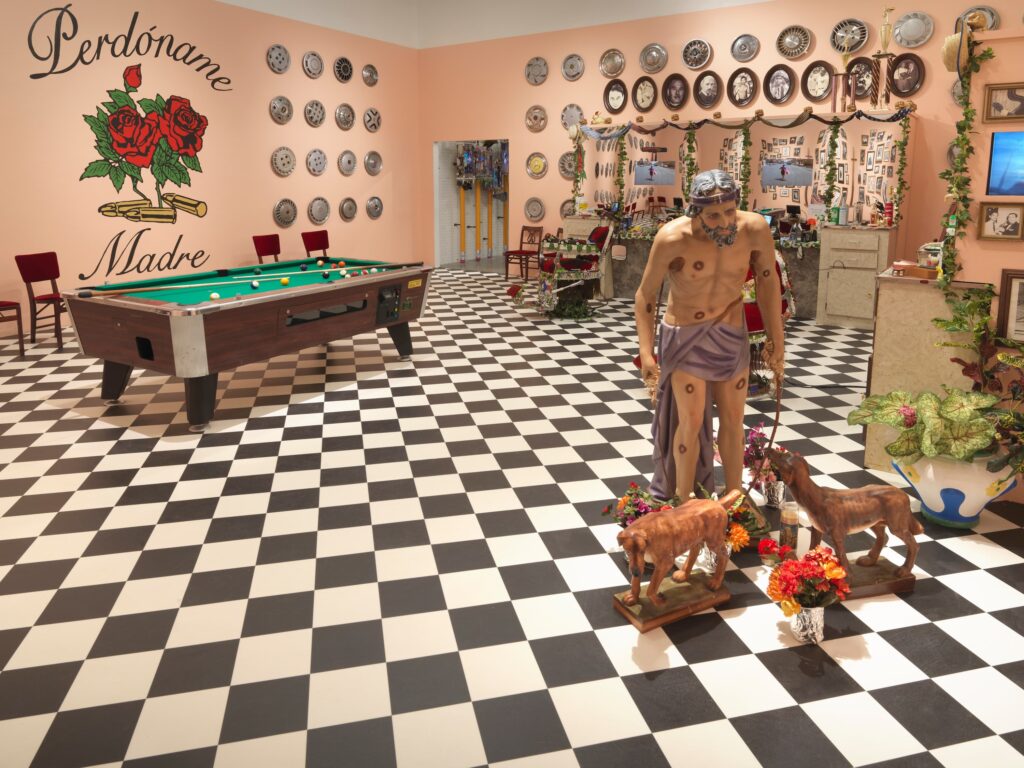
George Floyd’un öldürülmesi ve Black Lives Matter hareketinin küresel anlamdaki yükselişinin ardından, ırk ve Siyah karşıtı ayrımcılıkla ilgili tartışmalar Latin Amerika ve Karayipler’de önem arzeden bir ilgi görmeye başladı. Adada Siyah kimliğiyle tanınan Porto Rikolu sanatçıların sergileri 2020’den bu yana katlanarak arttı. Afrika kökenli Latinx sanatçıların müze ve galeri mekânlarına dahil edilmesinin, tanınmalarının, burslara erişimlerinin, sanatsal bir karşılık görebilmelerinin ve çalışmalarını sürdürebilmeleri için mali destek almalarının önünü açan bu hareketin nihayetinde ortaya çıkması tam 26 yıl aldı. Uluslararası ödüller alan ancak Porto Riko ya da Amerika Birleşik Devletleri’nin sanat çevrelerinde görünmez kalan sanatçılar, çalışmalarıyla tanınmaya ve desteklenmeye başladı. Pepón Osorio, Daniel Lind-Ramos, Awilda Sterling-Duprey, Gadiel Rivera ve Edwin Velázquez gibi isimler, çoğunluğunu ABD’den kuruluşların oluşturduğu Whitney Amerikan Sanatı Müzesi, New York Modern Sanat Müzesi, Mellon Vakfı, MacArthur Ödülü gibi bir çok saygın kurum tarafından hem sergilerle hem de ödüllerle kabul gördü. Bu tanınmanın getirisi olarak ada merkezli müze ve kurumların da Afro-Boricua sanatçıları tanımaktan başka çaresi kalmadı. Koloninin bir işe yaraması lazımdı! Black Lives Matter, hem adadaki hem de anakaradaki sanat kurumlarının temellerini sarstı ve bu kurumları, kapılarını uzun süredir sanat dünyasının dışında kalanlara açmaya zorladı.
Afro-görsel sanat üreticileri, müze ve galerilerdeki tipik klasik eğilimlere belirgin bir şekilde karşı çıkmak suretiyle, ataerkil ve dışlayıcı Avrupa-merkezci modelle ve onun yerleşik dolaşım ağlarıyla yüzleşiyor. Bu eserlerin çoğunda Siyah bedenin başrolde olması, kölelik ve ırkçılık dehşetinin yaşayan hafızası ve varlığı olarak kendini dayatıyor. Afro-Boricua sanatı bu bedenleri yeniden konumlandırıyor ve onları kendi referans sistemleri içinde yeniden bağlamsallaştırıyor. Bu bedenler, Porto Riko kültürü bağlamında ırkçılık ve ırksallaştırma deneyimi ve hafızası perspektifinden Porto Riko’daki tarihi, etiği ve estetiği yeniden okuyan; kendi bölgeleri, toplulukları ve ataları içine yerleştirilmiş ve onlarla etkileşime giren bedenlerdir.
Awilda Sterling-Duprey’in I am the reincarnation of an enslaved soul [Ben köleleştirilmiş bir ruhun reenkarnasyonuyum] (2021-22) adlı performansında Maestra Sterling, büyük ressam Rafael Tufiño’nun annesi Gregoria Figueroa’ya ait portresi Goyita’yı (1953) yeniden canlandırıyor. Sterling-Duprey portreyi, ABD sömürgeciliğinin dayattığı ilerleme modelinin başarısız olduğu Porto Riko’nun çağdaş koşulları içerisine yerleştiriyor. Performanstaki anlatı, çağdaş Afro-Boricua sanatı bağlamı üzerinden şekilleniyor. Dayatılan Afro-Latinx/Boricua bütünleşmeciliğinin ırkçılığı ile Porto Riko halkı ve diasporasının sömürgeleştirilme mantığı, köleliğin asla sona ermediği tezi üzerine oturuyor. Söz konusu temalar Brenda Torres-Figueroa, Brenda Cruz, Deyaneira Lucero Maldondo ve Las Nietas de Nonó’nun (Mulowayi ve Mapenzi) performanslarında da benzer şekilde ele alınıyor. Mayores ve Mayoras figürleri -büyükanneler, teyzeler, yoldaşlar, vaftiz anneleri, ebeveynler ve vaftiz babaları- yeniden maddeselleştirilmiş bir biçimde, kişisel/ailevi tarihte ve/veya sanatçıların kendi bedenlerinde yeniden/somutlaşmış olarak sunulmak suretiyle atalara/topluluğa ait bir vizyon ön plana çıkarılıyor. Böylelikle, resmi tarih ve Avrupa-merkezci söylemler tarafından silinmiş olan Afro-Karayip kimliğini kurtaran bir özne tanımının kaynağı olarak ailesel/toplumsal bir iç içe geçişi öneriyorlar. Sterling-Duprey, Cruz, Torres-Figueroa, Mulowayi ve Mapenzi’nin hikâye anlatıcılığının içerisinde gömülü olan benlik önerileri, bedene, deneyime ve tarihsel, politik ve ırksal belleğe yeniden gömülür; zamanın ve tarihin modern tanımlarına göre henüz “aşılmamış”, ancak bedende ve bedenden hareketle hala canlı olan bir kimliktir. Bireyle birbirine bağlı, parçalı, çoklu ve yaratıcı bir ilişkidir ve ses, hareket ve bir sanat eserini görselleştirme, yaratma ve canlandırma eylemiyle harekete geçirilen somutlaşmış bir hafızanın varlığını öne sürer. Böylelikle sanat işleri deneyime açılan kapılar işlevini görür. Yaşayan benliğin böylesi etkinleşmelerinin şiirselliği, çoklu-geçici ama yine de son derece anlamlı bir şekilde tarih ve benlikle derin bir bağlantı kurmaya davet ediyor. Bu yapı, sanatı pazarın ve müze ve galeriler tarafından onaylanmanın bir nesnesi olarak gören geleneksel anlayışları yıkıyor ve Afro-görsel sanatı hem toplumsal hem de atalara ait bir süreç, başkalarının deneyimleriyle ve aynı zamanda varoluş ve kimliğin yeniden tanımlandığı bir alan olarak toprakla bağlantılı bir biçimde yeniden tanımlıyor.
Bu kaygılar, Pepón Osorio, Diógenes Ballester, Imna Arroyo, Celso González, José Arturo Ballester Panelli’nin çeşitli sanat eserleri ve enstalasyonlarının yanı sıra Nuyorikalı grafiti sanatçısı Juan Sánchez’in resimleri ve duvar resimleri, Juan Pablo Vizcaíno’nun maskeleri ve Daniel Lind-Ramos’un asamblajlarının merkezinde yer alıyor. Bu isimlerin ortak noktaları, sanatsal önermeleriyle mekânı (ister kamusal, ister alternatif, isterse de müzelerde olsun) işgal etmeleridir. Bu sanatçılar Porto Riko’daki görsel sanatı, çevre, doğa ve hafızayla, yani ırksallaştırmaya uğramış tüm unsurlarla yeniden bağlantı kurmanın bir yolu olarak sunuyorlar. Bu pratikler, resmin veya fotoğraflanmış ya da boyanmış sanat eserinin iki boyutluluğuna direniyor. Onlar buluntu, geçici veya doğal malzemeleri kullanırken, sanatın yaşam ve toplumla etkileşiminde ısrar ediyorlar. Bu malzemeleri kullanmaları, sanatçıların adalar denizini, tüm toplulukları ve muhitleriyle birlikte görmelerine ve buradan doğru yeni atasal nesneler yaratmaya odaklanan bir Afro-Boricua estetiğini tekrardan oluşturmalarına olanak tanıyor. Bu eserler, kendi hikâye anlatımlarında alternatif anlamlar inşa ederek, kullanılan malzemeler aracılığıyla güzel olanı yeniden tanımlıyor. Berber koltuğu, yapraklar, pigmentler, doğal lifler sadece tıbbi yardımcılar olarak değil, aynı zamanda ırksallaştırmayı ve sosyal ötekileştirmeyi iyileştirmek için de kullanılıyor. Buna ek olarak aile fotoğrafları, mektuplar, videolar ve “bizim oraların insanları”nı simgeleyen öğeler ile sanatçıların kökenleri ve kendilerine ait eşyalarının kullanılması, eseri söz konusu alternatif mekân içerisinde bir temele oturtuyor. Antropolojik ya da sosyolojik bir bakış açısı benimsemek yerine, bakış açısı kendi içerisinden ortaya çıkıyor ve ilkel olanı tasvir eden gösteri paradigmasını bozuyor. Bu bakış açısı, doğayı salt bir manzara olarak gören romantik anlayıştan kaçınarak tüm canlı varlıkların iç içe geçtiği kutsal bir algıyla uyum sağlar. İnsanlığı yalnızca ilerlemenin bir üreticisi olarak değil, aynı zamanda tüm varoluşla uyum içinde olan doğal bir güç olarak yeniden tanımlamayı amaçlar.
Günümüz Afro-Boricua estetiğinin üç temel unsuru bir araya getirdiğini vurgulamakta fayda var: beden ve onun yeniden varoluşu, Afro maneviyatı ve doğasının dili ile Afro-Boricuaların kuzey ABD’ye göçmesiyle yaratılan mekânlar ve diller. Bu unsurlar, günümüz toplumuyla çatışmalar yaratmanın yanı sıra, potansiyel iyileştirici anlamlar da üretir. Bu durdurulamaz bir harekettir; ada ve dışındaki geleneksel sanat çevrelerinin ırksal kısıtlamalarına rağmen, dünyamızı yeniden görmenin yollarını mümkün kılan, sanatsal üretimin alternatif bir kaydıdır. Sömürgeciler artık gökyüzünü elleriyle kapatamazlar. Başka bir gerçeklik, dünyanın görsel dünyasını başka dünyaları da kapsayacak şekilde genişleterek kendini dayatıyor ve dayatacak.

Çeviri: Erdem Gürsu, yazının diğer dillerdeki versiyonları bağlantıda!
Protocinema’nın yeni dijital yayını PROTODISPATCH, sanatçıların kıtalararası kaygıları ele aldığı, kişisel bakış açılarını içeren deneme serilerinden oluşuyor. İngilizce dilinde yayınlanan denemeler Argonotlar ve Protocinema işbirliğiyle önümüzdeki yıl boyunca her ay Türkçe olarak Argonotlar’da kendine yer bularak bu küresel kaygıların Türkiye sanat ortamında da tartışılmasına alan açacak. Protodispatch’in diğer yayın partnerleri, Bangkok’dan GroundControlth.com

